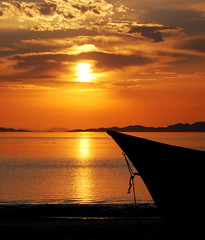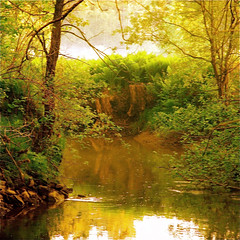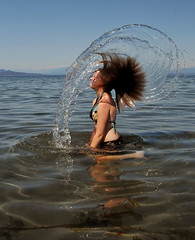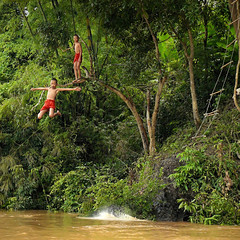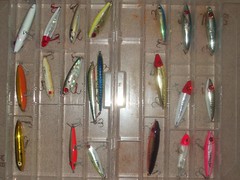Mature kings are doin' their thing right now in West Michigan Rivers and drowned river mouths. It wasn't too many years ago that the thought was these fish wouldn't strike baits or lures; hence the whole snagging mess. What a mistake that was, both in terms of the environment and for angler knowledge in general.
We now know that river and lake run kings will hammer angler's offerings if not for food, maybe just out of pure meanness. And there are many ways to catch them. Trolling and casting presentations as well as spawn presentations all prove very effective on late summer mature kings.
As a full time guide I start targeting river mouth kings in the Manistee, usually in mid-August and move south to the White and Muskegon rivers as the runs in these rivers peak later. Traveling from north to south in this manner I can usually hit active fish for six weeks or more.
Three presentations account for the majority of the kings we land from the river mouths and lower ends of the rivers
CRANKIN'
Casting crankbaits for river kings is by far my favorite way to catch them. Kings smash into cranks like you have snagged a locomotive. And crankbaits are so versatile, you can fish them close to cover, you can fish them fast and shallow or slow and deep.
Cranks work best in water from four to eight feet in depth and they’re especially effective early in the season when rivers are low and slow. When the rivers are low and slow there are some areas where there isn’t enough current to effectively drop back plugs or drift spawn. Cranks have their own inherent action and vibration which proves especially annoying to river run kings.
My favorite crankbait for catching river kings is Dave's Deep Ka-Boom Shiner in Firetiger. Other productive lures include Deep Thunderstick Juniors, and Rapala Shad Raps.
While it's tempting to think big when it comes to salmon fishing, I've found that medium sized cranks seem to out perform larger ones. A lot of that probably has to do with the fact that larger cranks tend to run deeper than smaller ones.
Also, don't over look jerk baits like Dave's Ka-Boom Shiner, X-Raps and shallow Husky Jerks. At times, especially during early mornings, kings will take these lures right near the surface. And if you think that top-water for bass is fun, you should see one of these lures being mauled by a raging king.
Last year on a particularly hot day of fishing one of my clients was quickly reeling in a fouled crank. It was spinning along the top of the water when a king slammed the mess. After that I experimented with Bass type buzzbaits and found them remarkably productive for kings staging right at the river mouths in low light conditions. One word of warning: Cheap is good. One king on a buzzbait and the bait is destroyed.
When it comes to crankbait color, my most consistent producer is a fire-tiger pattern. But other combinations of chrome and chartreuse or orange also work well especially on sunny days.
Fishing near cover is key to crankin' up river kings. Crank near log jams if you can find them, or trees that have fallen partially into the water. If there's a tree in the water be sure to crank just up stream and downstream of it.
No matter how good the cover looks, if the fish aren't there it's worthless. If you’re not seeing actively rolling, or jumping fish, they’re probably not in the area.
Another trick for triggering strikes is to change the swimming direction of the crankbait. By moving your rod tip from an upstream angle to a down stream angle and back again, you subtly change the direction the lure is swimming. And often that subtle change is all that is needed to trigger a strike. On a typical retrieve I usually change the direction two or three times.
SKEIN & FLOATS
A big chunk of salmon roe suspended below a bobber can be unbelievably productive, especially right at the river mouths. I like large slip floats on 20# Siglon F floating line made by SunLine. This line floats on top of the water which is a big advantage for this type of fishing because it's much easier to stay in contact with the float.
I run the Siglon F right to the float and then attach a 15# fluorocarbon leader by way of a blood knot from just below the float to the hook. Last year I experimented with Owner circle hooks and found them to perform very well. All the fish were hooked right in the corner of the mouth keeping the line from rubbing against the fishes teeth.
Long rods (eleven feet or more), allows for long leads from the float to the bait. Last year at the mouth of the Manistee we were setting the floats about 10 feet above the bait, while fishing about 20 feet of water. This rigging produced a few 20 plus fish days. Catching kings on a rig most reminiscent of bluegill fishing is a thrill that takes you back to simpler times.
BACK BOUNCING
Back bouncing skein and tied spawn sacks is a very effective technique, especially for fish that have been in the river a while. While much of the back bouncing on the Big Manistee happens from boat anchored above holes, I've found that a mobile approach, using an electric trolling motor to be much more effective.
I use the trolling motor to move slightly slower than the speed of the current working the skein on pencil sinker rigs out behind the boat. Fishing in this manner allows me to fish entire runs and holes from top to bottom. There's no question that there are times to sit tight a concentrate on one area. More often than not though, covering water puts more fish in the boat.
For back bouncing I like nine foot medium-heavy action spinning rods and a quality reel spooled with 15 lb. mono . From a sliding pencil sinker to the skein I like 12 lb. fluorocarbon with a stout #4 egg hook.
There's no question that our salmon are smaller than they were just ten years ago. But catching them in rivers on comparatively light tackle will still test the mettle of the most experienced angler. This September give West Michigan's river kings a shot I'll guarantee the last thing you'll complain about is the size of the fish.





